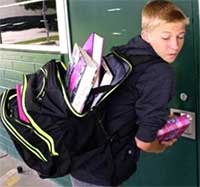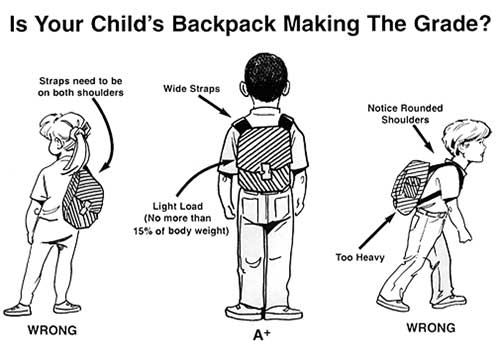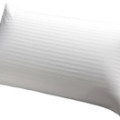Fall is quickly approaching and so the start of school is just around the corner. I know it seems like summer just started! Schools are requiring younger and younger kids to carry more and more books home nightly and so it is important to choose a good backpack for your child.
Backpack Basics
Backpacks are useful to carry all the required school items, keep things organized with different pockets, and express a person’s style. They range from $10-$60 or more and come in lots of styles including traditional backpacks, shoulder/tote bags, messenger bags, and rolling backpacks. It is important to choose a backpack that fits the person wearing it in size and style AND puts the least amount of strain on his/her body. If worn improperly the child can end up with neck, back, and/or shoulder pain. When worn properly the weight is distributed evenly across the torso, making injuries less likely. Carrying a messenger or shoulder/tote bag places all the weight on one side of the body and causes the child to lean to the opposite side to counteract the pull. This causes improper muscle strain on both side of the back, neck, and shoulders. For this reason traditional and rolling backpacks are the best options.
How to Wear a Backpack
As mentioned earlier, it is best to use a traditional two strap backpack or one with wheels. Unfortunately most school systems have banned the usage of rolling backpacks. I suppose they have done this because it can be a tripping hazard to those around them? With that being said, below are general guidelines to wear your backpack correctly:
- Always wear 2 straps over your shoulders
- Tighten each strap so that the backpack rests in the middle of his/her back and doesn’t sag down to the buttocks
- Distribute the weight as evenly as possible throughout the backpack with heaviest items placed closest to the child
Weight of the Backpack
Doctors and most physical therapists recommend that the child’s loaded backpack be no more than 10-15% of their body weight. For example if a child weighs 70 pounds his backpack should weigh 7-10.5 pounds. An easy way to check the weight of your child’s backpack is to place it on the bathroom scale. One consideration is that during growth spurts, “adolescents’ spines are changing and it’s a good idea to be careful about increasing stress on the lower back,” Dr. Pierre d’Hemecourt of the Division of Sports Medicine at Boston Children’s Hospital says. This is more important in those children who play sports that cause back extension such as gymnastics, ballet, figure skating, and the inside lineman in football. (http://www.outdoors.org/articles/blogs/great-kids-great-outdoors-blog/how-heavy-should-my-childs-backpack-be/)
If your child’s backpack is too heavy consider these tips:
- Encourage your child to use his/her locker/desk frequently during the day to prevent carrying all his/her books with them during the day
- Only carry necessary items in the backpack
- Only bring home the books that are needed for studying/homework each night
- If needed, have the child carry some books in their arms
(http://www.unitedhealthchiro.com/wp-content/uploads/2015/08/backpack.gif)
Choosing the Right Backpack for School – Final Thoughts
Backpacks can be useful tools to assist your child carry all the necessary school supplies, but can cause neck, back, and/or shoulder pain if worn improperly or loaded too heavily. I have provided some tips to use when wearing and loading the backpack. Remember it should weigh no more than 10-15% of the child’s weight.




